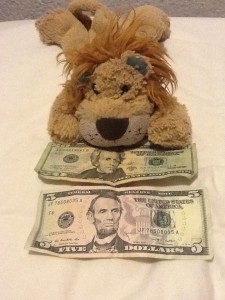Lewis the Lion had already had some practice with converting Sterling to the US Dollar on his worldwide adventure, as he discovered that it was the currency in Ecuador when he had travelled there. (Check out this blog post to learn more about the conversion rates). He learnt that the American dollar is often used in international transactions and is one of the strongest currencies in the world. For example, when he was in Mexico, Helen paid for her diving course in American dollars and not in Mexican pesos.
However, when Lewis the Lion arrived in America, he discovered that there is a whole new language surrounding the coins used in America. He knew that there were 100 cents in the dollar but here are the alternative, slang names that he learnt for the different coins.
a buck – a dollar
a quarter – 25 cents
a dime – 10 cents
a nickel – 5 cents
a penny – 1 cent
A thousand dollars could be referred to as a grand, a bit like a thousand pounds in the UK.
What surprised Lewis the Lion about his American adventure was that in each state, the would add different sale taxes onto the advertised price, e.g. 7.25%. That meant that whenever Lewis the Lion had to buy something he always had to account for a little bit extra when he got to the counter.
Using a calculator, work out how much the following amounts would be if you were adding 7.25% onto the cost.
– 99 cents
– $2.49
– $10
– $19.99
-$38

